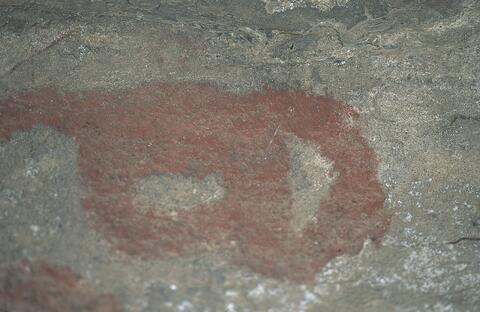Identity area
Reference code
Title
Date(s)
- 12/12/2005 (Creation)
Level of description
Extent and medium
Context area
Name of creator
Biographical history
Brief description of site: The shelter is about 50m in length, 4m high and 5m deep. Site faces to the north. Paintings are scattered throughout the shelter
Brief description of art: In the eastern end of the shelter is a white undulating form with red flecks along its back. The form may be associated with a nearby hole in the rock. The form is probably the remnants of a depiction of a snake. Snakes have many associations in San thought, but are most often associated with rain. The association with the hole in the rock is probably significant. The rock face was not seen as a 'neutral' canvas on which images could be painted. Instead, it was seen as a 'membrane' or 'veil' between the real, human world and the spirit world; the spirit world existed just behind the surface of the rock. Paintings are frequently depicted coming out of or going into cracks, steps or bosses in the rock, in effect, from the human to the spirit world (or vice versa).
Just below the putative snake is a red, curvilinear, finger-painted design. What it is meant to represent is unknown, but it probably relates to other red finger-painted images recently recognized in the Maclear art. The cultural affiliations and meaning of these images is not yet known, but is the subject of ongoing research.
The main panel in the centre of the shelter has depictions of a number of eland and human figures in the 'arms-back' posture. Both are significant. In general terms, the eland antelope was believed by the San to be the most powerful of animals, containing large quantities of a 'supernatural potency' that the southern /Xam San called !gi. This potency was drawn upon by shamans (medicine men) to enter the spirit world where they healed the sick, controlled rain, influenced the movements of game and visited far-off places. Paintings of eland were also reservoirs of potency that shamans could use to enter the spirit world during the ritual trance dance.
The panel also includes a section of thin red line fringed with fine white dots. Seven centimeters of the line are clearly visible, but the line was originally probably longer. Two human figures stand on the faded end of the line. Paintings of this sort have been explained by recently recorded ethnography from the Kalahari San. They describe shamans climbing along 'threads of light' from the human world to 'god's house' in the sky. It is now thought that thin red lines depict these threads of light. In the paintings, humans are often depicted as if either holding the lines or walking on them. Thin red lines often go into (or come out of) steps or cracks in the rock.
A hollow in the rock in the western end of the shelter has a group of six or seven (the exact number is unclear) human figure in the arms back and bending forward postures. These distinctive postures are adopted by shamans only during the healing or trance dance during which shamans are believed to visit the spirit world. Bending forward at the waist is caused by stomach cramps during the dance; figures adopt the arms back posture when 'asking god to put potency into them'. They are painted over another thin red line with white dots (the white dots are faint).
Name of creator
Name of creator
Biographical history
Repository
Archival history
Immediate source of acquisition or transfer
Content and structure area
Scope and content
Appraisal, destruction and scheduling
Accruals
System of arrangement
Conditions of access and use area
Conditions governing access
Conditions governing reproduction
Language of material
- English
Script of material
Language and script notes
Physical characteristics and technical requirements
Original size: 35mm

